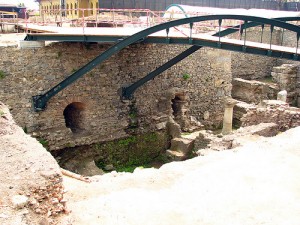What’s under the Blue Mosque?
 Norman asks what’s buried under the Blue Mosque.
Norman asks what’s buried under the Blue Mosque.
Ever since Indiana Jones found that ‘X’ sometimes does mark the spot, Hollywood- and armchair historians everywhere- have been salivating at the prospect of finding some lost treasure hidden just below the surface. Most of the time this is just wishful thinking. Archeology is slow, painstaking work, not treasure hunting. But Constantinople is more a city of ghosts than most- its modern custodians are the very people who destroyed it, and they show little interest in preserving or exploring an alien past. So Byzantium keeps its secrets and provides a richer ground for future discovery than perhaps any other ancient megapolis. The Blue Mosque is a perfect case in point.
Directly beneath it lies the oldest part of the Great Palace of the Byzantine emperors. It was built by Constantine the Great as his personal residence and was nicknamed the Palace of Daphne because of a famous statue of Apollo’s nymph displayed on the grounds. Some of the most prominent early Byzantine structures were within its walls- the octagonal bedchamber decorated with a cycle of mosaics of the imperial family, the subterranean walkway and stair to the imperial box in the Hippodrome, and the chapel of St. Stephen where on Christmas Day in 820 one of the most cold-blooded murders in Byzantine history was carried out. (The previous evening, emperor Leo V had thrown his scheming friend Michael the Amorian into prison for a conspiracy, and sentenced him to die by being bound to an ape and cast into the furnace that heated the imperial baths. Early Christmas morning Michael’s supporters snuck into St. Stephens disguised as monks, and dismembered their unarmed sovereign)
The Palace of Daphne was also the original coronation hall, and as late as the Macedonian Dynasty was still being used for imperial weddings. The emperors of the eleventh and twelfth centuries preferred the gentler views of the Blachernae Palace in the nortwestern corner of the city, so Daphne gradually fell into decline.
It was still mostly intact (though partly in ruins) when the city fell to the Turks, but in 1606 after a sharp military defeat, the Ottoman Sultan decided to distract the population by building a huge mosque. He pulled down a large section of the Hippodrome (including the lavish imperial box), leveled the Palace of Daphne and erected the Blue Mosque. Only the walls above ground were destroyed, however. The southern side of the mosque rests completely on the foundations and vaults of the Byzantine Palace.
Given the history of the building, even its ruins would be a gold mine of information. Don’t count on seeing it anytime soon though. Even if it wasn’t under a mosque, imperial remains aren’t exactly a high priority. Justinian’s magnificent Bucoleon Palace was pulled down in 1873 to make way for a railway station, and the surviving part of the Blachernae Palace was converted to a tile factory. Until Turkey discovers an appreciation of Byzantium we’ll have to settle for this virtual reconstruction from our friends at Byzantium 1200: http://www.arkeo3d.com/byzantium1200/daphne.html